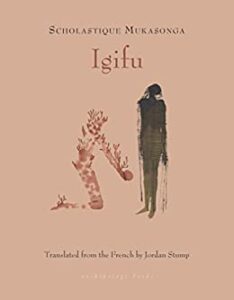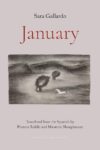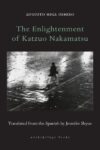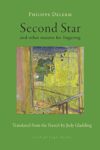
[Archipelago Books; 2020]
Tr. from the French by Jordan Stump
Read in order, Igifu is a study in collective grief and trauma that finds its strengths through the observations of ritual. Writer Scholastique Mukasonga is interested in the inability of the human mind to conceptualize genocide, overwhelming in its evilness and reach. As her characters find themselves unable to articulate what has transpired, her stories verbalize the horror of genocide in ways drastically abstract, beautifully and imaginatively rendered. The ineffectiveness of language to explain trauma parallel the creation of ritual employed in the aftermath of violence. The diverse set of characters throughout the five stories in the collection take small actions one at a time, forming habits that work like amulets, as a way to endure. These joint ideas guide the narratives in Igifu to depict the patterns of learning to live in the midst of tragedy.
A French-Rwandan writer, Mukasonga’s 2018 novel The Barefoot Woman, also published by Archipelago, was a finalist for the 2019 National Book Award for Translated Literature. Mukasonga has won several of French literary prizes, including the Prix Renaudot. Her newest short story collection is translated by Jordan Stump, and the prose feels crisp and sharp as Mukasonga’s rhythmic language shines through in the translation. The stories play with several different narrators and perspectives, characters of all ages, memories and the present. Each of the stories have different connections to the ethnic cleansing in Rwanda of the Tutsi people, although many stories center around earlier displacements of Tutsi communities which preceded the 1994 Tutsi Genocide.
“Igifu,” the first story in the collection, sets the standards early on for Mukasonga’s masterful storytelling, in addition to instructing the reader in how to interact with the other stories in the collection. Igifu is the name of a monster, the personification of hunger, which begins to taunt the child narrator of the eponymous story. Mukasonga writes that Igifu, “was the heartless magician who conjured up lying mirages . . . and then just when you were about to reach out for that mouthwatering food it would all dissolve like the mist on the swamp, and then you heard Igifu cackling deep in your stomach.” Putting this story first in the collection cues the reader in early, letting us know how Mukasonga will play with the folk tales and fables and parables, exploring one thing by calling it something else, creating a two-fold type of narrative storytelling that underscores each of the stories in the collection. The five year old narrator tells us, “As you know, it’s bad luck for Rwandans to leave the house in the morning without first having something to eat. We call that gusamura.” Likewise, Igifu the monster becomes hunger by another name. Mukasonga presents us with a short story about the reality of being hungry, talking about it, working around it, but without calling it what it is. Her young character is not yet ready to confront the enormity of the situation by name. Later in the collection, this imagery is reproduced when we’re offered a monster in a latrine. The blurry line created between reality and magical realism mirrors the difficulty many of the characters in the collection face as they grapple with mundane struggles after otherworldly disasters.
The other thread that runs through the collection is an interest in ritual, magical thinking, and the habits formed around grief, trauma, and displacement. The young narrator tells us her ritual to hide from Igifu: “at the foot of my parents’ big bed there was a clay pot with a few pieces of leftover sweet potato, saved for us as always by Mama. As I did every morning, I felt around for the two little pieces of sweet potato.” Our narrator would let us believe it’s because of the loss of ritual that Igifu comes, not the loss of food caused by her family’s deportation for being Tutsi.
One of the strongest stories in a collection full of strong stories, “The Glorious Cow,” is focused on a Tutsi community tending their cows. Mukasonga writes, “Then everyone collected his own cows, which could take time, but that forest of horns was a beautiful sight, one that all the men of the hill never tired of admiring.” The narrative details every aspect of how a family and a people group care for livestock. Throughout the story, the rituals involved in milking the cows, caring for them, building their structures are a yearning for survival collectively performed by a community. Later in the story, after the Tutsi are deported and their livelihoods taken from them, the narrator tells us, “my father spent his days leading his phantom cows into the fields of memory and regret.” The story tells us about how a Tutsi community raises cows, but we hear the narrator’s yearning for a previous lifestyle, a communal exile, a village later lost to violence.
“The Curse of Beauty” follows Helena, whose beauty and Tutsi identity become her downfall. Out of the entire collection, this story feels the closest to a fairy tale. It’s also the most involved with the politics of the ethnic cleansing of the Tutsi, even naming political figures and working them into the story. The narrative buzzed the most alert for me as a reader when describing Helena’s clothes, her cosmetics, the way she does her hair. These small moments of self-care, of the aliveness she presents in a doomed fate, offer themselves as rituals meant to create order in a disordered and doomed world.
Exploring the ideas of residual fear in a life after violence, “Fear” follows drills run in a small village of displaced Tutsi, where everything turns upside down when there is a threat to safety. The narrator often speaks in the third person, representing a community acting together out of trauma. The drills and their repetition offer an idea of safety found in routine. The narrative details how quickly any semblance of function is undermined, derailing everything built in a moment. Mukasonga writes, “For us children, those days of great fear were above all days of great excitement: nothing was the same as usual, everything was topsy-turvy!” As the mind tries to rationalize the unbelievable, it’s left unable to categorize and organize events with the right emotions, to make sense of what’s underway.
Mukasonga writes often about the difficulty of naming events or feelings. In “Grief,” the narrator struggles with finding the right words to describe the genocide, a word which she finds, “too serious.” She’s trying to describe what’s happened both as an attempt to explain her past in the country where she’s immigrated but also to understand for herself. Her grief proves too complex to fit into one word.
Mukasonga’s critique of language and its shortcomings feels particularly striking when read in Stump’s translation, which follows rhythm and voice closely. The characters’ attempts to articulate the indescribable mirror of the reality of reading translation, which can only offer a representation of the original instead of a reproduction. Failed by language, the characters often turn to magical thinking. To the untrained eye, the small rituals and habits crafted by the characters would go unnoticed, but Igifu’s strength is found in the way it trains the reader to notice these small acts as endurance and resilience.
Sarah McEachern is a reader and writer in Brooklyn, NY. Her recent work has been published in Catapult, Pigeon Pages, Entropy, Pacifica Literary Review, and The Spectacle. Her reviews, criticism, and interviews have been published or are forthcoming in Rain Taxi, Pen America, Split Lip, The Believer, The Ploughshares Blog, and Gulf Coast.
This post may contain affiliate links.






